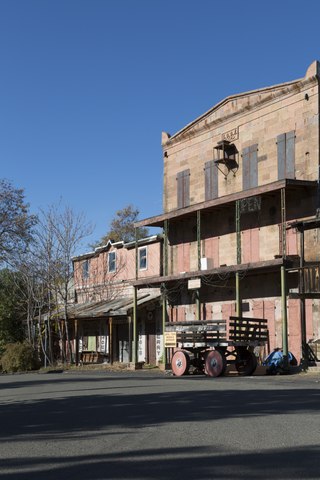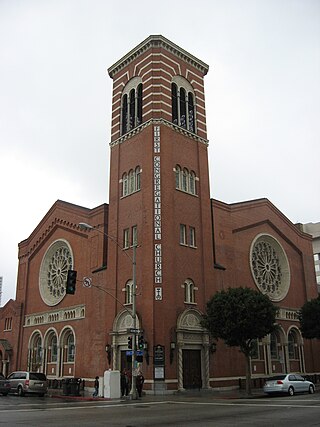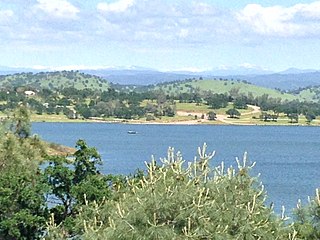
Amador County is a county located in the U.S. state of California, in the Sierra Nevada. As of the 2020 census, the population was 40,474. The county seat is Jackson. Amador County, located within California's Gold Country, is known as "The Heart of the Mother Lode". There is a substantial viticultural industry in the county.

Calaveras County, officially the County of Calaveras, is a county in both the Gold Country and High Sierra regions of the U.S. state of California. As of the 2020 census, the population was 45,292. The county seat is San Andreas. Angels Camp is the county's only incorporated city. Calaveras is Spanish for "skulls"; the county was reportedly named for the remains of Native Americans discovered by the Spanish explorer Captain Gabriel Moraga.

Mokelumne Hill is a census-designated place (CDP) in Calaveras County, California, United States. The population was 646 at the 2010 census, down from 774 at the 2000 census. It is commonly referred to as "Moke Hill" by locals. The town takes its name from the neighboring Mokelumne River, which in turn is Miwok for the "people of Mokel," the likely name of a Native American village in the area.

State Route 49 is a north–south state highway in the U.S. state of California that passes through many historic mining communities of the 1849 California gold rush and it is known as the Golden Chain Highway. The highway's creation was lobbied by the Mother Lode Highway Association, a group of locals and historians seeking a single highway to connect many relevant locations along the Gold Rush to honor the 49ers. One of the bridges along SR 49 is named for the leader of the association, Archie Stevenot.

The Mokelumne River is a 95-mile (153 km)-long river in northern California in the United States. The river flows west from a rugged portion of the central Sierra Nevada into the Central Valley and ultimately the Sacramento–San Joaquin River Delta, where it empties into the San Joaquin River-Stockton Deepwater Shipping Channel. Together with its main tributary, the Cosumnes River, the Mokelumne drains 2,143 square miles (5,550 km2) in parts of five California counties. Measured to its farthest source at the head of the North Fork, the river stretches for 157 miles (253 km).

The Hotel Léger, in Mokelumne Hill, California is one of the oldest hotels still operating in California. The hotel and courthouse building are registered as California Historical Landmark #663, and located in present-day Calaveras County, California.

First Congregational Church is a church of the United Church of Christ located in downtown Long Beach, California. The church occupies a historic red brick structure that was built in 1914. The Italian Romanesque Revival building has been designated as a Long Beach Historic Landmark and was added to the National Register of Historic Places in 2012.
Poverty Bar is a former settlement in Calaveras County, California, active from c. 1850s to 1862, and now covered by the waters of Camanche Reservoir. The nearest major town is Campo Seco, California.

The I.O.O.F. Hall in Mokelumne Hill, California, which is California Historical Landmark #256, is said to be California's first three-story building to be erected outside the coastal towns. The original building was erected in 1854 as a two-story building. A third story to be used for lodge purposes was added in 1861.
Middle Bar is a former mining town on the Mokelumne River in Amador County, California. It is a California Historical Landmark.

Old North Church (ONC) is in Sierra Madre, California and is a historic landmark building built in 1890, one of the oldest churches and buildings in Sierra Madre. The Old North Church is owned by it builder Sierra Madre Congregational Church, called First Congregational Church of Sierra Madre at the time of completion. It is site #50 on Sierra Madre designated historical landmarks list. There are forty-eight properties listed on Sierra Madre's Designated Historical Properties List. In September 2018 Sierra Madre Congregational Church changed its name to Christ Church Sierra Madre.
The Superior Court of California, County of Calaveras, also known as the Calaveras County Superior Court, is the branch of the California superior court with jurisdiction over Calaveras County.

The Superior Court of California, County of Trinity, also known as the Trinity County Superior Court, is the branch of the California superior court with jurisdiction over Trinity County.

The Sonora Hebrew Cemetery, also known as Pioneer Jewish Cemetery, is an inactive Jewish cemetery founded in c. 1851, and located in Sonora, California. This was the first Jewish cemetery in the Gold Rush region.
Marysville Hebrew Cemetery also known as Marysville Jewish Cemetery, and Jewish Cemetery of Marysville, is a no longer active Jewish cemetery founded in 1855 by the Marysville Hebrew Benevolent Society, and is located at the southeast corner of Marysville Cemetery, in Marysville, California. In 1945, the cemetery was abandoned and forgotten; by 1995 it was restored.
Nevada City Jewish Cemetery is a no longer active Jewish cemetery founded in 1854 by the Nevada Hebrew Society, and located in Nevada City, Nevada County, California. The last burial was during the summer of 1890. There are only 29 headstones that are visible. On October 29, 1972, the site was dedicated as a historical site.
Jackson Pioneer Jewish Cemetery, also known as Givoth Olam, is a no longer active Jewish cemetery founded in 1857 by the Congregation B'nai Israel, and is located in Jackson, Amador County, California. By 1921, the cemetery was closed.

The Big Bar, also called Upper Bar, is a gold mine in Jackson, California, United States. The mine opened in 1848 along the Mokelumne River and is registered as California Historical Landmark #41.

Double Springs, California, is a historical site of the form town in Calaveras County, now in Valley Springs, California. The town was built during the California Gold Rush. Double Springs was founded on February 18, 1850, two years after the start of the California Gold Rush. Double Springs grew so quickly that it was the seat of Calaveras County in 1850. The County seat was a coveted honor and a year later, in 1851, Jackson was able to claim the title, but only for a year. In 1852 by popular vote, Mokelumne Hill was able to become the County seat until 1866 when it move to San Andreas. The Double Springs was in what is called the California Mother Lode mining region. The Double Springs old courthouse was built in 1849, and was moved, its original spot is now rural land. A foundation mark was placed at the site of the old courthouse, installed by the Calaveras Chamber of Commerce. The courthouse is now at the Calaveras County Museum Complex in San Andreas. Double Springs received its name from two springs nearby springs that are between the low hills nearby. Alexander R. Wheat built a large house from squared sandstone in 1860, the house is still there. One of the other remains of Double Springs is a family cemetery. Double Springs site is about 3.6 miles east of Valley Springs and is mostly rural land near Youngs Creek. The site of Double Springs is a California Historical Landmark No. 264.
Peter L. Traver Building is a historical building in Murphys, California in Calaveras County. The building was built by Peter L. Traver in 1856. The building is the oldest stone building in Murphys. Being made of stone, built with iron shutters and Peter L. Traver Building placing sand on the roof protected the building from the town's many fires. Fire swept through the town in 1859, 1874, and 1893. Peter L. Traver was a gold Rush miner who opened a general store in the building. Traver sold the building to the Manuel Estate Company in 1883. Over the years the building has been a general store, warehouse, a Wells Fargo office, and auto repair garage. From age and lack of repairs, the building was set to be taken down in 1949. Dr. Coke Wood and his wife Ethelyn after hearing this, purchased and restored the building. The descendants of the Woods family have turned the Peter L. Traver Building into the Murphys Old Timers Museum. In 2016 the Museum became a community museum, run by volunteers and supported by donations and gift shop sales. Many in the community have donated artifacts to the Museum about Murphys' gold-rush history. The Peter L. Traver Building is a California Historical Landmark No. 266.















